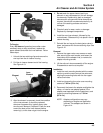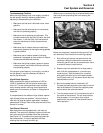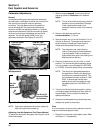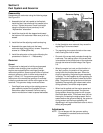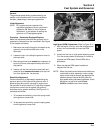
5.4
Section 5
Fuel System and Governor
Carburetor
General
These engines are equipped with fixed main jet
carburetors manufactured by Keihin to Kohler
specifications. Most have automatic chokes and fuel
shut-off solenoids. Keihin carburetors with accelerator
pump features are standard on many models, and are
furnished as an option on other CH applications where
improved performance is required during periods of
rapid acceleration. Both types are almost identical
except for the accelerator pump parts shown in the
inset in Figure 5-8. Most information in the following
pertains to both type carburetors, with differences
pointed out or shown wherever pertinent.
WARNING: Explosive Fuel
Gasoline is extremely flammable and its vapors can
explode if ignited. Store gasoline only in approved
containers, in well ventilated, unoccupied buildings,
away from sparks or flames. Do not fill the fuel tank
while the engine is hot or running, since spilled fuel
could ignite if it comes in contact with hot parts or
sparks from ignition. Do not start the engine near
spilled fuel. Never use gasoline as a cleaning agent.
Troubleshooting - Carburetor Related Causes
Condition
Possible Cause/Probable Remedy
1. Low idle fuel mixture (some models)/speed improperly adjusted.
Adjust the low idle speed tab, then adjust the low idle fuel needle.
1. Engine starts hard, runs roughly or
stalls at idle speed.
2. Engine runs rich (indicated by
black, sooty exhaust smoke,
misfiring, loss of speed and power,
governor hunting, or excessive
throttle opening).
2a. Clogged air cleaner. Clean or replace.
b. Choke partially closed during operation. Check the choke lever/
linkage to ensure choke is operating properly.
c. Low idle fuel mixture is improperly adjusted. Adjust low idle fuel
needle (some models).
d. Float level is set too high. Separate carburetor air horn from
carburetor body, adjust float according to steps 4 and 5 on page
5.7.
e. Dirt under the fuel inlet needle. Remove needle; clean needle and
seat and blow with compressed air.
f. Bowl vent or air bleeds plugged. Remove low idle fuel adjusting
needle. Clean vent, ports, and air bleeds. Blow out all passages
with compressed air.
g. Leaky, cracked or damaged float. Submerge float to check for
leaks.
3. Engine runs lean (indicated by
misfiring, loss of speed and power,
governor hunting or excessive
throttle opening).
3a. Low idle fuel mixture is improperly adjusted. Adjust low idle fuel
needle (some models).
b. Float level is set too low. Separate carburetor air horn from
carburetor body, adjust float according to steps 4 and 5 on page
5.7.
c. Idle holes plugged; dirt in fuel delivery channels. Remove low idle
fuel adjusting needle. Clean main fuel jet and all passages; blow
out with compressed air.
4. Fuel leaks from carburetor. 4a. Float level set too high. See Remedy 2d.
b. Dirt under fuel inlet needle. See Remedy 2e.
c. Bowl vents plugged. Blow out with compressed air.
d. Carburetor bowl gasket leaks. Replace gasket.






